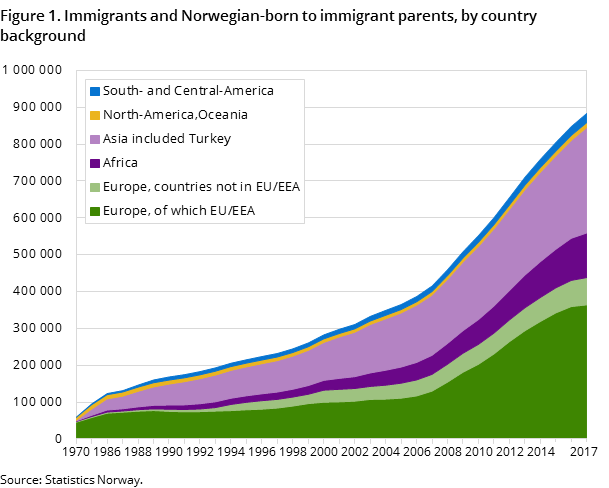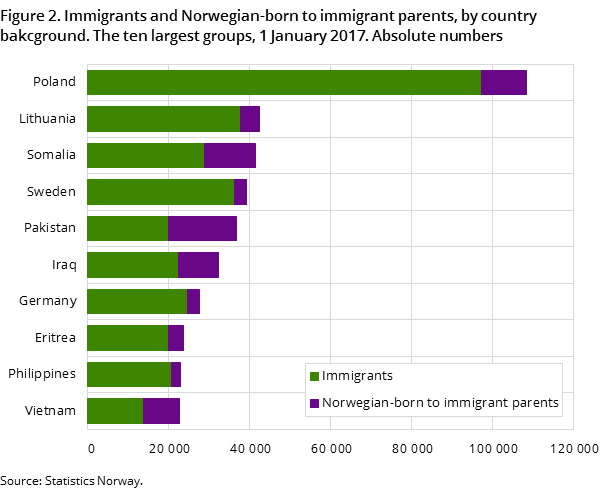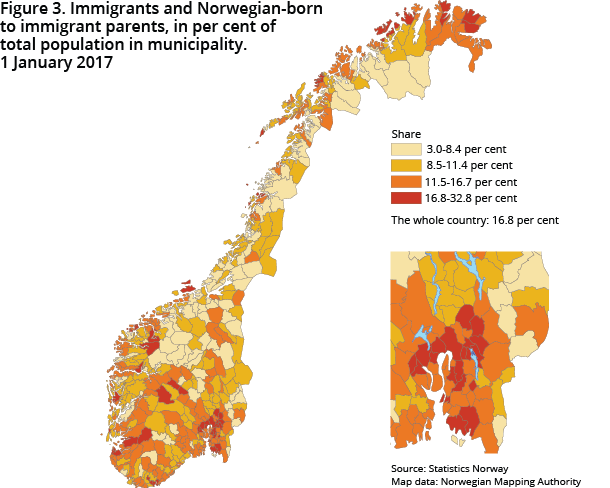Content
Published:
Updated:
This is an archived release.
Many new Syrian immigrants
At the beginning of 2017, there were 725 000 immigrants and 159 000 Norwegian-born to immigrant parents in Norway. The highest relative growth in 2016 was among immigrants from Syria.
| 2017 | ||||
|---|---|---|---|---|
| Immigrants and Norwegian-born to immigrant parents, total | Immigrants | Norwegian-born to immigrant parents | Immigrants and Norwegian-born to immigrant parents in per cent of total population | |
| Total | 883 751 | 724 987 | 158 764 | 16.8 |
| The EU28/EEA, USA, Canada, Australia and New Zealand | 377 522 | 341 321 | 36 201 | 7.2 |
| Asia, Africa, Latin America, Oceania except Australia and New Zealand, and Europe except the EU28/EEA | 506 229 | 383 666 | 122 563 | 9.6 |
| EU28/EEA countries | 364 127 | 328 808 | 35 319 | 6.9 |
| European countries outside EU28/EEA | 74 032 | 57 745 | 16 287 | 1.4 |
| Africa | 121 111 | 90 501 | 30 610 | 2.3 |
| Asia including Turkey | 286 407 | 213 987 | 72 420 | 5.4 |
| North America | 11 107 | 10 301 | 806 | 0.2 |
| South and Central America | 24 786 | 21 538 | 3 248 | 0.5 |
| Oceania | 2 181 | 2 107 | 74 | 0.0 |



The number of immigrants grew by 26 400 in 2016, which is the lowest percentage growth since 2002.
Immigrants accounted for 13.8 per cent of the total population in Norway as per 1 January 2017, while Norwegian-born to immigrant parents accounted for 3 per cent. These two groups have a background from 221 different countries and independent regions.
Immigrants from Syria had highest growth
The growth in the Syrian immigrant group during 2016 was 11 100. At the beginning of 2017, there were 20 800 immigrants from Syria, while the corresponding figure for the previous year was 9 700.
Additionally, 1 500 Norwegian-born to immigrant parents from Syria were registered as resident in the same period.
Persons with an immigrant background from Syria now make up the eleventh largest group in Norway, nearly the same size as the entire population of Steinkjer municipality.
Still most Polish immigrants
The growth in the Polish immigrant group during 2016 was 1 500. Despite the record low percentage growth, immigrants from Poland are still the largest immigrant group, with 97 200 persons. An imaginary municipality solely consisting of Polish immigrants would be the sixth largest municipality in Norway in terms of number of inhabitants.
The second largest group of immigrants is made up of Lithuanians, with 37 600 persons. Swedes are in third place with 36 300, followed by Somalians, with 28 700.
Most Norwegian- born to Pakistani, Somali and Polish parents
Norwegian-born to immigrant parents from Pakistan made up the largest group of all Norwegian-born to immigrant parents, with 16 700. Norwegian-born to Somali parents were the second largest group (12 800), followed by those with parents from Poland (11 000).
How many in the so-called third generation?
Persons born in Norway with two Norwegian-born parents and four foreign-born grandparents are not included in Statistics Norway’s definition of population with an immigrant background. This group totalled exactly 1 013 persons as of 1 January 2017. The grandparents of this group most commonly immigrated to Norway in the 1970s, and their parents were born in the 1970s or later. Just 13 persons are aged 18 or older, and 70 per cent of the group are below the age of 6. Over half of the group has a Pakistani background. Other groups include Turkey and Morocco.
One in three with an immigrant background in Oslo
Oslo had the largest population of immigrants and Norwegian-born to immigrant parents, both in relative terms and absolute figures. Of Oslo’s 666 800 inhabitants, 166 400 were immigrants and 52 4001 were Norwegian-born to immigrant parents as per 1 January 2016. These two figures combined constitute 33 per cent of the capital’s entire population. The proportions in Båtsfjord and Drammen were also high, with 29 and 28 per cent respectively.
All suburbs in Oslo were above the national average of 16.8 per cent. The suburbs with the highest proportions of persons with an immigrant background were Stovner, Søndre Nordstrand and Alna, with over 50 per cent.
1 The number were corrected at 11 September 2017.
Additional information
Contact
-
Oppdrag innvandring
E-mail: oppdraginnvandring@ssb.no
-
Alice Steinkellner
E-mail: alice.steinkellner@ssb.no
tel.: (+47) 90 72 90 51
-
Statistics Norway's Information Centre
E-mail: informasjon@ssb.no
tel.: (+47) 21 09 46 42
